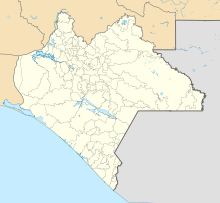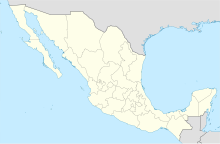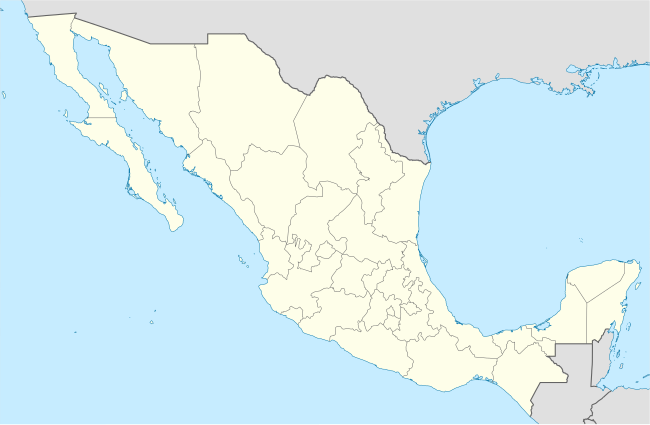Tuxtla Gutiérrez International Airport
Tuxtla Gutiérrez International Airport Aeropuerto Internacional de Tuxtla Gutiérrez | |||||||||||
|---|---|---|---|---|---|---|---|---|---|---|---|
 | |||||||||||
| Summary | |||||||||||
| Airport type | Public | ||||||||||
| Owner/Operator | Grupo Aeroportuario de Chiapas | ||||||||||
| Serves | Tuxtla Gutiérrez | ||||||||||
| Location | Chiapa de Corzo, Chiapas, Mexico | ||||||||||
| Time zone | CST (UTC-06:00) | ||||||||||
| Elevation AMSL | 457 m / 1,499 ft | ||||||||||
| Coordinates | 16°33′49″N 093°01′21″W / 16.56361°N 93.02250°W | ||||||||||
| Website | www | ||||||||||
| Map | |||||||||||
 | |||||||||||
| Runways | |||||||||||
| |||||||||||
| Statistics (2024) | |||||||||||
| |||||||||||
Source: Grupo Aeroportuario de Chiapas | |||||||||||
Tuxtla Gutiérrez International Airport (Spanish: Aeropuerto Internacional de Tuxtla Gutiérrez), officially known as Aeropuerto Internacional Ángel Albino Corzo (Ángel Albino Corzo International Airport) (IATA: TGZ, ICAO: MMTG), is an international airport situated in the municipality of Chiapa de Corzo, Chiapas. It serves air traffic for Tuxtla Gutiérrez and a significant part of the State of Chiapas, including San Cristóbal de las Casas and Comitán.
The airport is operated by Grupo Aeroportuario de Chiapas, a government-owned corporation. It replaced the Francisco Sarabia National Airport, which is now exclusively used for military purposes. According to official statistics from the Civil Aviation Federal Agency (AFAC), the airport handled 1,681,980 passengers in 2024, a 5.71% decrease from previous year.[1]
History
[edit]

Earlier airports
[edit]The first commercial airport serving Tuxtla Gutiérrez was opened in 1957 in Terán, located to the west of the city. This small airport had limited capacity and technical constraints. In 1980, operations were relocated to the Llano San Juan airport in the neighboring municipality of Ocozocoautla. However, this new location faced challenges such as fog and wind conditions that made commercial aviation difficult. Various investments were made to address these issues, including the installation of radio systems and the construction of a second runway, but they proved unsuccessful. As a result, by the late 1990s, the old Terán Airport had to be temporarily used to carry out flight operations. The need for a third airport in Tuxtla Gutiérrez became more apparent in the early 2000s as the existing air infrastructure could not fully meet the city's growing commercial air traffic demands.[2]
Initial operations
[edit]In 2006, the new Angel Albino Corzo Airport in Chiapa de Corzo was inaugurated. The investment for this project amounted to 825 million pesos (72.2 million dollars), with 49% of the funding coming from the federal government and 51% from the state government. With the commissioning of this new airport, the old Terán airport resumed its role as a military airbase, and the Llano San Juan airport ceased aviation operations completely.
The airport's official inauguration took place on June 27, 2006, with President Vicente Fox and the State's Governor Pablo Salazar Mendiguchía in attendance. The first commercial flight to land at the airport was Aviacsa's flight 234 from Tapachula, which used a Boeing 737-201/Adv aircraft with registration number XA-TVL.[3] The first departure from the airport was on the same aircraft bound for Mexico City.[4]
The airport was initially designed with the capacity to handle 350 daily operations and serve 850,000 passengers per year.[4] It officially received its international airport status in 2008 and welcomed its first non-commercial international flight in September of the same year when the Canadian national football team arrived for a match against the Mexico national football team at the Víctor Manuel Reyna stadium.[5]
Expansion
[edit]
In November 2014, plans were announced to expand the airport with the aim of increasing the terminal's capacity from 80,000 to 140,000 passengers per month. In the following year, the airport achieved a significant milestone by welcoming its one-millionth passenger on board Interjet flight 2601, marking the first time in its history to reach this level of passenger traffic.[6] The airport also made history by receiving the Mexican Air Force's Boeing 787-8 on August 7, 2017, which was the largest aircraft to land at the airport.
In 2020, the airport underwent a significant expansion, increasing its facilities by 140% to a total of 22,472 square meters.[7][8] This expansion included the addition of commercial areas, four new points of contact, and a new apron.
In December 2023, the state government announced a new expansion of the facilities to handle the anticipated passenger growth. A new 6,000 square-meter wing will include a mezzanine, documentation counters, baggage documentation and reclaim area, restrooms, retail and airline space, and premises for health, immigration, and customs authorities. The expansion will also include a new short-haul bus terminal. Works are expected to be completed in 2024.[9]
Additionally, a new air cargo terminal was inaugurated in February 2024. It has its own apron and taxiway, housing fiscal storage areas, a cold chamber, and spaces for companies specialized in air cargo. A second phase will include a 60-hectare industrial park, scheduled to be completed by July 2024.[10][11]



Route development
[edit]Initially, only two airlines operated at this airport, offering flights to Mexico City: MexicanaClick, a subsidiary of Mexicana, and Aviacsa, which faced bankruptcy in 2009. In the same year, Interjet introduced a daily flight to Toluca, while Aeroméxico briefly provided three daily flights from Mexico City.[12] Additionally, MexicanaLink introduced flights to Oaxaca, Guadalajara, and Mérida, while Mexicana took over its route to Mexico City. After Mexicana's bankruptcy in 2010, Aeroméxico decided to expedite the launch of its operations, offering five daily frequencies, with four of them operated by Boeing 737 aircraft and one using ERJ 145 aircraft. Simultaneously, Interjet redirected its flights from Toluca to Mexico City and increased the frequency to five daily flights.
Between 2010 and 2013, Continental Express (later United Express) operated flights to Houston. In 2010, Viva initiated flights to Monterrey, Guadalajara, and Cancún. They expanded their services to Mexico City in 2016 and added Mérida and Puebla in 2018. In December 2012, Volaris launched the route to Mexico City, later extending to Guadalajara in 2013, Tijuana from 2013 to 2015, Monterrey from 2014 to 2017, and Cancún since 2015. TAR offered flights to Toluca and Mérida from 2014 to 2018, and Aeromar to Villahermosa, Mérida, and Oaxaca from 2016 to 2018. Calafia briefly served flights to Palenque and Puebla in 2018. The regional airline Aerus launched services to Villahermosa in October 2023, but withdrew the service two months later.[13]
As of February 2025, the airport is connected to seven regular destinations in Mexico, served by four commercial airlines. Volaris introduced new flights to Mexicali and León/El Bajío in July 2023,[14] both suspended in 2024, and will re-introduce service to Monterrey in March 2025.[15] Viva commenced flights to the new Felipe Ángeles airport in Mexico City in April 2024.[16]
Facilities
[edit]
The airport is located at an elevation of 457 metres (1,499 ft) above mean sea level and covers an area of 740 hectares (1,800 acres). It includes a 2,500 metres (8,200 ft) concrete runway, a parallel taxiway, a passenger terminal for commercial aviation, a general aviation apron, multiple hangars, and a military base.
The passenger terminal is a two-story structure with a total area of 22,472 square metres (241,890 sq ft), designed to separate departure and arrival areas on different levels. The upper floor houses check-in counters, a security checkpoint, and a departure pier with eight gates equipped with fixed jet bridges. Two of these gates are capable of accommodating large aircraft like the Boeing 767 and the Airbus A330.
The lower level serves arriving passengers and features immigration and customs facilities for international travelers, baggage claim areas, and an arrivals hall. The airport also offers a restaurant, a VIP lounge, a café, a snack kiosk, various retail stores, ATMs, wireless internet access, and facilities designed to cater to individuals with disabilities.
Airlines and destinations
[edit]Passenger
[edit]| Airlines | Destinations |
|---|---|
| Aeroméxico | Mexico City |
| Aeroméxico Connect | Mexico City |
| Viva | Cancún, Guadalajara, Mérida, Mexico City, Mexico City–AIFA, Monterrey |
| Volaris | Cancún, Guadalajara, Mexico City, Monterrey (begins March 30, 2025),[15] Tijuana |





Destinations map
[edit]Destinations from Tuxtla Gutiérrez International Airport Red = Year-round destination Blue = Future destination Green = Seasonal destination |
Traffic statistics
[edit]Passengers
[edit]Graphs are unavailable due to technical issues. Updates on reimplementing the Graph extension, which will be known as the Chart extension, can be found on Phabricator and on MediaWiki.org. |
Annual traffic
[edit]| Year | Passengers | Freight (Tons) | Aircraft movements |
|---|---|---|---|
| 2006 | 334,181 | 571 | 7,649 |
| 2007 | 704,903 | 1,312 | 13,756 |
| 2008 | 788,486 | 1,099 | 15,862 |
| 2009 | 663,479 | 1,001 | 12,832 |
| 2010 | 650,053 | 1,081 | 12,367 |
| 2011 | 803,611 | 1,046 | 14,182 |
| 2012 | 786,829 | 1,284 | 15,674 |
| 2013 | 855,073 | 901 | 15,930 |
| 2014 | 928,243 | 1,164 | 17,980 |
| 2015 | 1,121,332 | 1,132 | 18,067 |
| 2016 | 1,272,689 | 1,236 | 19,325 |
| 2017 | 1,342,345 | 1,346 | 20,151 |
| 2018 | 1,388,706 | 1,287 | 17,832 |
| 2019 | 1,496,152 | 1,343 | 17,768 |
| 2020 | 756,786 | 755 | 10,813 |
| 2021 | 1,186,528 | 885 | 13,774 |
| 2022 | 1,590,178 | 784 | 15,723 |
| 2023 | 1,784,010 | 911 | 16,307 |
| 2024 | 1,681,980 | 982 | 15,884 |
Busiest routes
[edit]| Rank | City | Passengers | Ranking | Airline |
|---|---|---|---|---|
| 1 | 401,434 | Aeroméxico, Aeroméxico Connect, Viva, Volaris | ||
| 2 | 122,029 | Viva, Volaris | ||
| 3 | 121,169 | Viva, Volaris | ||
| 4 | 83,361 | Viva | ||
| 5 | 43,828 | Volaris | ||
| 6 | 34,151 | Viva | ||
| 7 | 32,110 | Viva | ||
| 8 | 8,549 | Volaris | ||
| 9 | 5,346 | Volaris | ||
| 10 | 1,104 | TAG Airlines |
See also
[edit]- List of the busiest airports in Mexico
- List of airports in Mexico
- List of airports by ICAO code: M
- List of busiest airports in North America
- List of the busiest airports in Latin America
- Transportation in Mexico
- Tourism in Mexico
- Tourism in Chiapas
- San Cristobal de las Casas
- Lacandon Jungle
References
[edit]- ^ "Estadística Operacional de Aeropuertos / Statistics by Airport". Agencia Federal de Aviación Civil. Retrieved 28 January 2025.
- ^ "Llano San Juan and Santa Lucía, useless airports". Excelsior (in Spanish). June 2019. Retrieved 26 May 2023.
- ^ "Fotos en FsMex.com: Aviacsa - Boeing 737-201". FsMex.com (in Spanish). October 2013. Archived from the original on 16 October 2013. Retrieved 15 October 2013.
- ^ a b "Tuxtla Gutierrez International Airport". Aeropuertos y Servicios Auxiliares. Retrieved 28 February 2017.
- ^ "Llegó primer vuelo internacional al aeropuerto de Chiapas". Agencia de Servicios Informativos de Chiapas (in Spanish). September 2008. Retrieved 15 October 2013.
- ^ "Tuxtla Gutierrez airport reaches a million passengers" (in Spanish). Grupo En Concreto. November 2015. Retrieved 3 December 2015.
- ^ "Amplían Aeropuerto Internacional Ángel Albino Corzo" (in Spanish). Centro Urbano. Retrieved 1 January 2021.
- ^ "Ampliación y modernización del Aeropuerto de Tuxtla Gutiérrez "Ángel Albino Corzo" registra 40 por ciento de avance" (in Spanish). Chiapas en Contacto. Retrieved 20 December 2019.
- ^ "Cornerstone laid for the second expansion of Angel Albino Corzo International Airport". Meganoticias (in Mexican Spanish). 21 December 2023. Retrieved 24 December 2023.
- ^ "CIIT, Key to Chiapas Industrialization". Real Estate Market (in Mexican Spanish). April 2024. Retrieved 3 April 2024.
- ^ "International Airport's cargo apron and hangar inaugurated". El Heraldo de Chiapas (in Mexican Spanish). 12 February 2024. Retrieved 3 April 2024.
- ^ "Manuel Velasco celebra nuevo vuelo Toluca-Tuxtla Gutiérrez". Grupo Sexenio Comunicaciones (in Spanish). November 2012. Retrieved 4 December 2014.
- ^ "Aerus adds two more destinations from Villahermosa". Euro.ES. August 2023. Retrieved 29 August 2023.
- ^ "Volaris NS23 Domestic Network Expansions". Aeroroutes. June 2023. Retrieved 6 June 2023.
- ^ a b "Volaris NS25 Monterrey Network Expansion". Aeroroutes. Retrieved 15 January 2025.
- ^ "Viva Aerobus Bets Big on AIFA: 17 New Routes". Aviacionline. September 2023. Retrieved 28 September 2023.
- ^ "Estadística operacional por origen-destino / Traffic Statistics by City Pairs" (in Spanish). Agencia Federal de Aviación Civil. January 2025. Retrieved 5 February 2025.
External links
[edit] Media related to Ángel Albino Corzo International Airport at Wikimedia Commons
Media related to Ángel Albino Corzo International Airport at Wikimedia Commons- Official website
- Aeropuertos ASA
- Tuxtla Gutiérrez Airport information at Great Circle Mapper
- Aeronautical chart and airport information for MMTG at SkyVector
- Current weather for MMTG at NOAA/NWS
- Accident history for TGZ at Aviation Safety Network
- Tourism in Tuxtla Gutiérrez


 French
French Deutsch
Deutsch

